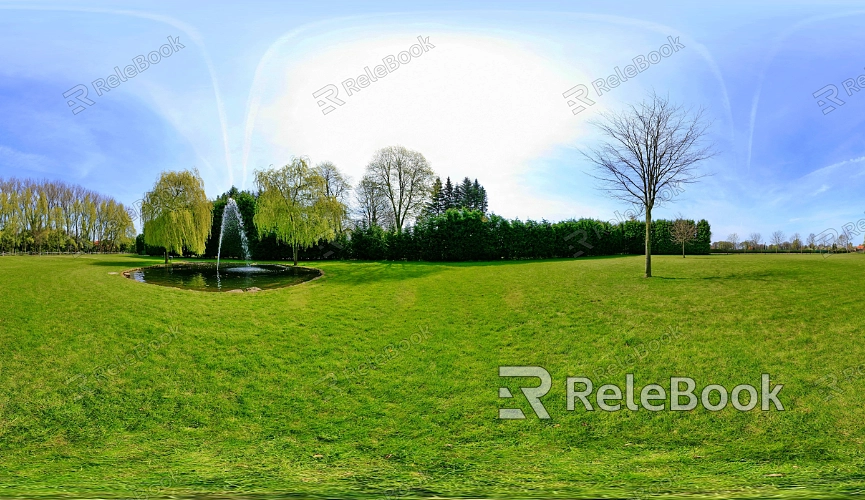How to Adjust Grass Texture HDR Lighting in 3ds Max
When working with outdoor natural scenes, HDR files offer rich lighting information that can create realistic shading effects on grass textures. However, different scenes may require adjustments to the HDR lighting to achieve the desired visual impact. In this article, we will discuss how to fine-tune grass texture HDR lighting in 3ds Max and offer solutions for common scenarios. Whether you are designing for games, animation, or architectural renderings, this guide will help you better understand how to optimize the lighting for grass textures.

1. Check the Basic HDR File Settings
Before diving into lighting adjustments, ensure that the HDR file you are using is of high quality and appropriate for the scene. Low-resolution HDR files may not provide enough detail, which can negatively affect the lighting results.
Resolution Check: High-resolution HDR files capture more details, which is especially important for complex grass scenes. The more details captured, the better the rendering results.
Exposure Adjustment: Some HDR files may come with excessive or insufficient exposure, leading to undesirable lighting effects. You can manually tweak the exposure settings in 3ds Max’s material editor to ensure a more balanced lighting.
2. Adjust Lighting Intensity Using VRay or Corona
3ds Max supports popular rendering engines like VRay and Corona, which provide robust lighting control options. By adjusting the HDR lighting intensity, you can achieve an optimal grass texture look.
VRay Dome Light: In VRay, you can use the Dome Light to load an HDR file and modify its intensity to control the overall brightness of the scene. Increasing or decreasing the intensity allows you to fine-tune the balance between light and shadow on the grass texture.
Corona Sun and Sky: For Corona users, combining HDR files with the Corona Sun & Sky system allows you to better simulate natural lighting. This can enhance the realism of the grass texture by creating a more convincing lighting environment.
3. Modify the HDR Rotation Angle
In some cases, the lighting direction in the HDR file may not align with the layout of your scene. Rotating the HDR file can change the direction of the light source, altering the shadows and highlights on the grass.
Optimizing the Rotation Angle: Within 3ds Max’s material editor, you can adjust the horizontal angle of the HDR file to match the scene’s lighting needs. For example, you may want sunlight to hit the grass from a specific direction to create more natural shading effects.
Avoiding Excessive Glare: Certain lighting angles can cause overly intense reflections on the grass surface. By adjusting the HDR angle, you can minimize unwanted glare and improve the overall appearance.
4. Control Grass Reflection and Light Interaction
The grass texture is influenced not only by the intensity and direction of light but also by its reflectivity. By managing the surface’s reflection properties, you can more accurately simulate how light behaves in a natural setting.
Reflection Settings: In the material editor, reducing the grass’s reflectivity can soften harsh reflections, making the grass appear more natural.
Light Interaction Control: Fine-tuning parameters such as lighting models and refraction indices allows you to further optimize how the grass texture interacts with different lighting conditions.

5. Enhance Detail with Ambient Occlusion (AO)
To boost the level of detail in the grass texture, consider using Ambient Occlusion (AO) alongside HDR lighting. AO helps simulate how light is blocked in areas of close contact, making small details like blades of grass stand out.
Applying AO: By adding AO maps, you can enhance shadowing effects between grass elements, especially in areas with less direct lighting. This makes the grass appear more three-dimensional and lifelike.
Combining with HDR: When used together, AO and HDR lighting create a more refined overall lighting effect, highlighting subtle details within the grass texture.
6. Adjust Self-Illumination Settings for Grass Textures
In certain specialized scenes, you may want the grass itself to emit a subtle glow. This is often used in nighttime environments or to create specific moods. By adjusting the self-illumination properties of the grass material, you can achieve this effect.
Self-Illumination Settings: In the material editor, you can tweak the self-illumination parameters for the grass texture, making it appear slightly brighter or giving it a faint glow in darker environments.
Combining with HDR: While self-illumination is different from HDR lighting, they can complement each other, enhancing the overall atmosphere of the scene.
7. Optimize Render Settings for Best Results
The final step to ensure the adjusted HDR lighting on the grass texture is accurately displayed is optimizing the render settings in 3ds Max. The render settings play a crucial role in the output quality.
Ray Tracing and Global Illumination: Make sure ray tracing and global illumination (GI) are enabled in the render settings to enhance the realism of the grass texture under HDR lighting.
Rendering Output Settings: Achieving high-quality grass lighting effects requires adjusting resolution and sampling rates in the rendering output to capture every detail.
In this article, we’ve covered how to adjust the lighting for grass HDR textures in 3ds Max, from basic HDR file settings to advanced lighting techniques. These include using rendering engines like VRay and Corona, optimizing light angles, controlling reflections, and enhancing details with ambient occlusion. By making these adjustments, designers can achieve more realistic lighting effects when rendering grassy landscapes, elevating the overall visual quality of their scenes.
If you’re looking for high-quality HDR images, 3D textures, or models for SketchUp or 3ds Max to bring your virtual environments to life, Relebook offers a wide range of resources to help you achieve exceptional results in your projects.

